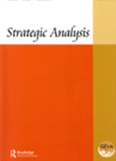Space Awareness: A Need for a Multilateral Mechanism
This article discusses the utility and limitations of existing space surveillance networks to address the issue of spaceflight safety and proposes a way forward. Specifically, it begins with a brief explanation of why space situational awareness (SSA) is important and draws attention to the existing major SSA networks followed by a brief summary of the major limitations of the US, Russian and Chinese networks. These limitations highlight why we collectively need to craft a better and more efficient mechanism. Finally, it concludes with a techno-political elucidation for the future.
- Ajey Lele |
- September 2013 |
- Strategic Analysis




